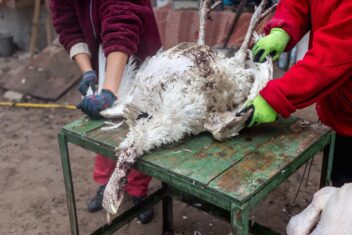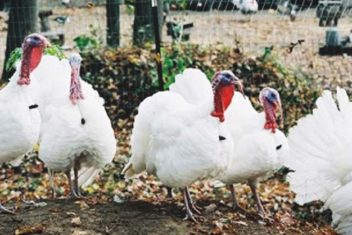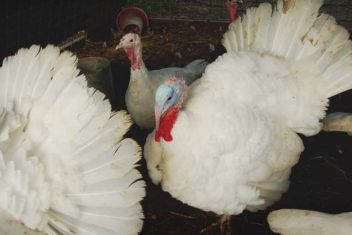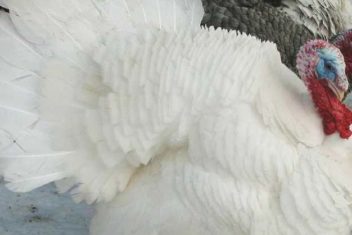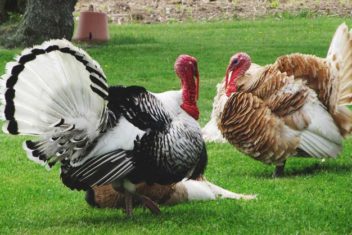Turkeys for profit? Is it possible?
I know some of you are laughing right about now because if homesteaders know anything – it’s that turkeys eat a great deal.
Any animal which eats a ton of food and has specific protein requirements (like turkeys) you know it’s going to cut into your profit.
But there are ways to raise turkeys for profit, and I’m going to share a few tips with you. It may put a glimmer of hope back in your eye over raising turkeys again.
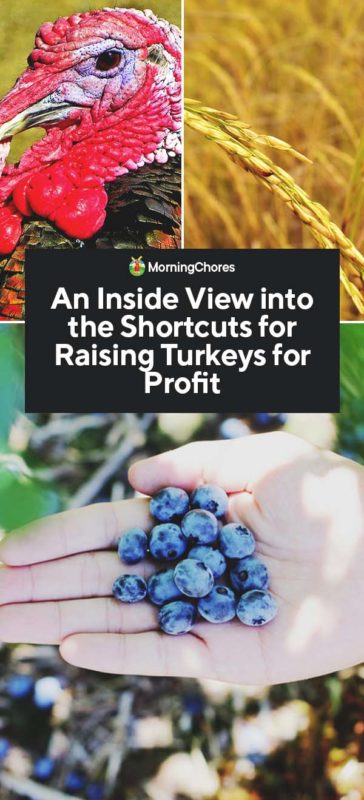
Let’s dive into the idea of how you can raise turkeys for a profit:
Raising Turkeys Poults
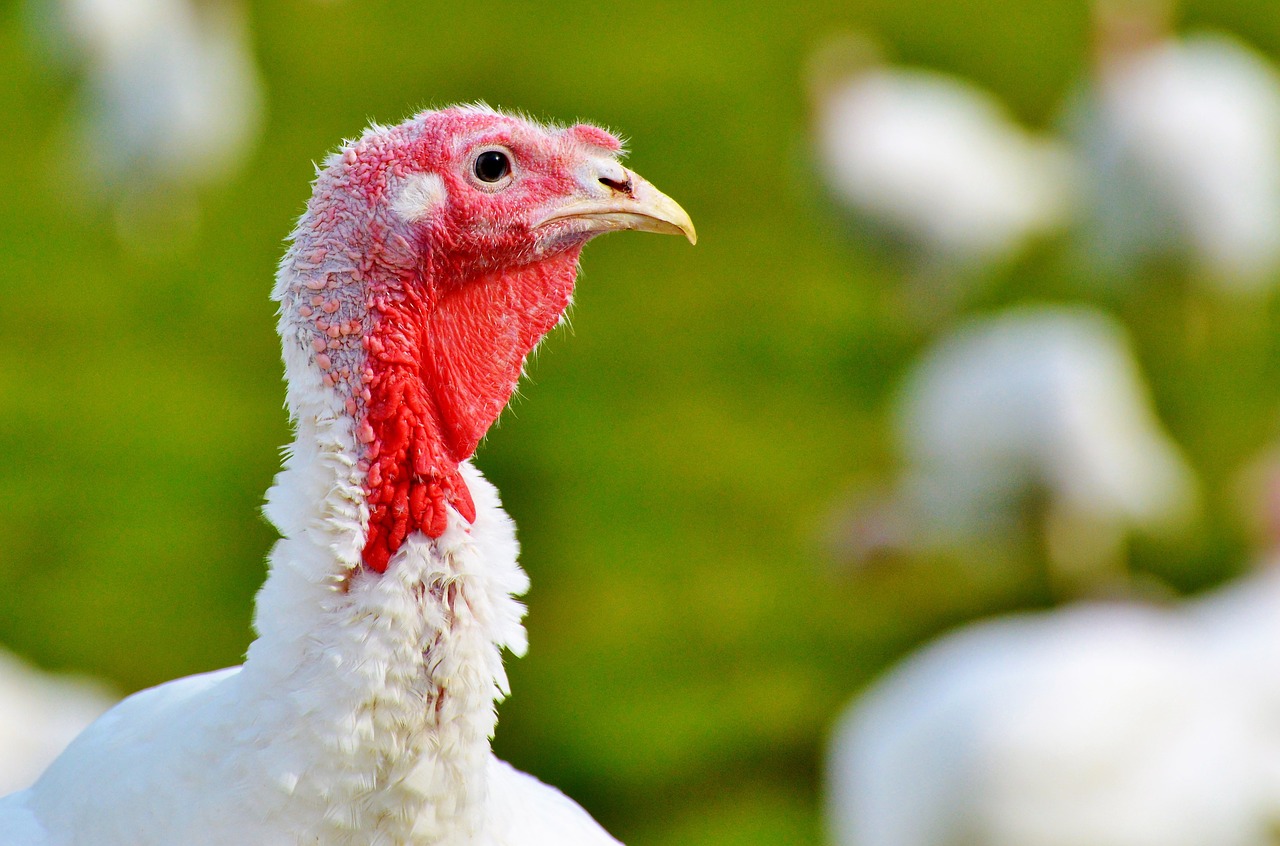
I’m going to start with the bad news. There are no short cuts when raising turkeys during the poult stage.
Baby turkeys have a hard time in the first month of life. This is when you can experience a significant loss of poults.
Turkeys have a hard time learning to thrive. They struggle with figuring out how to find their food and water. They struggle with eating the wrong items when mistaking it for food.
They pile up in the corners of a brood box and sometimes kill each other in the process. They also have specific heating and protein requirements. But here’s how you can avoid these fiascos and give your turkey poults the best shot at survival:
1. Food and Water Tricks
When placing turkey poults into the brooder box, make sure you dip their beaks in water. It will help them to know where to go to find their water, but you might have to repeat this more than once.
It also helps to put shiny objects in their water which should grab their attention. When they peck at the objects to soothe their suspicions, they’ll drink water in the process.
Make sure you feed your poults a high protein diet. In their earliest days of life, their diet should consist of approximately 26% protein.
As they get older and transition to a diet of game feed, the protein content can be decreased to 20%. When they get to the finishing stage, the protein can be reduced to around 18%.
Make sure when feeding turkey poults that you place a piece of cardboard under their feeder. If you don’t, they may confuse their bedding with feed which fell on the floor.
The poults will eat the bedding thinking it is food, and suffocate because they can’t swallow it.
2. Brooder Box Specifics
When placing your turkey poults in their brooder box, make sure the temperature stays between 95-100° Fahrenheit.
You can decrease the temperature by five degrees each week until they’re fully feathered and able to maintain their body temperature.
Also, be sure you place cardboard in the corners of the brood box to round them out. When turkeys become frightened, they’ll frequently pile on top of each other.
If you don’t round out the corners, the poults on the inside will get wedged into it. This habit can cause suffocation, or they can become lodged in the corner.
When you don’t catch this in time, the one at the bottom can die. By taking these few necessary steps it gives your turkey poults a much great chance at surviving their early days.
Raising Your Own Feed
The most significant reason it’s challenging to raise turkeys for profit is simply because they eat a ton! Male turkeys (or toms) can consume as much as 100 pounds of food over the six months it takes to grow them out.
There are a few ways you can help offset the cost of food. Here are a few ideas:
1. You Won’t Escape Buying Feed
Let’s be upfront about this fact: you won’t escape buying feed for your turkeys. They need a high protein diet.
Though you can do your best to supplement it, I wouldn’t chance meeting their needs. Therefore, buy the game bird feed and make it readily available to them.
Also, supplement their diet with what you can forage and grow yourself. They’ll most likely prefer the natural foods anyway.
But make sure they have a feed available to them which contains everything in one bite to make sure you don’t waste your efforts raising them.
2. Put Them on Pasture

If you have the land available, put your turkeys on pasture. You must have enough land you can rotate the birds around because turkeys will mow it down.
To take proper care of your pasture, it’s a good idea to rotate the birds to give the grass time to replenish itself.
By doing this you will also give the birds access to bugs, lizards, and snakes to feast on as a source of protein. Make sure you use electric fencing to protect your turkeys from predators and give them a space to roost off the ground for protection at night.
Turkeys on pasture could be a wonderful and natural option to feed them without the added expense.
3. Put Your Trees to Work
Do you have nut trees in your yard? Consider harvesting the nuts to feed your turkeys. When turkeys are in the wild, they eat nuts such as acorns, walnuts, and any other seed they can find available.
I have a ton of black walnut trees on our property. I otherwise don’t use them, but they make an excellent source for feed.
If you don’t have nut trees available, scour the internet. Some people will post when they have nuts in their yard. If you collect them, they’ll give them away free many times.
People like for them to be removed to avoid damaging their mower when they mow and to keep their lawn looking pretty.
Use the resources available to cut your turkey feed bill.
4. Raise the Grains
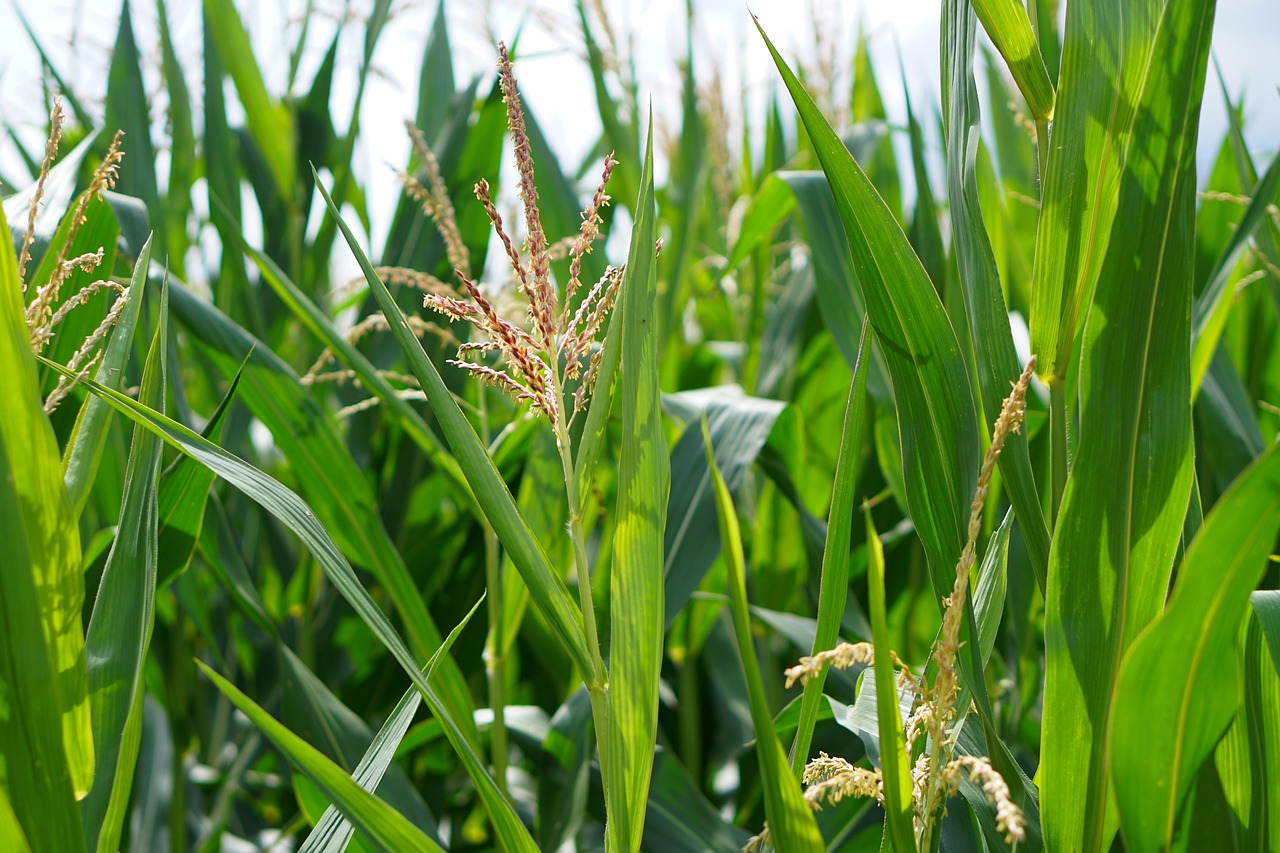
Some popular grains people raise to feed their turkeys are corn and wheat. Wheat makes an excellent cover crop over winter.
When you’re finished with it, harvest it and feed it to your turkeys. You can do the same with corn by planting it in a garden for the turkeys.
As the crop comes in, pick the ears of corn and feed it to the birds. No need to make it complicated. The birds will pick out what they want.
What they don’t use, compost it for your garden next year.
5. Pick Your Berry Patch

I grow a ton of berries around my property. We have blueberries, blackberries, raspberries, and strawberries.
By the end of the growing season, I’m worn out and tired of picking berries. I’ll have frozen, canned, and dried all I’m going to be able to use for the year.
Yet, they’ll still have more berries available. Don’t let them go to waste. Instead, pick them and feed them to your turkeys.
They’ll appreciate the treat and your wallet will appreciate the break.
6. Save Your Grass Clippings and Weeds
We live on 10 acres, and we mow four of those acres. I don’t mind because I love the view of fresh cut grass in the front yard, and it’s a peaceful chore to do around the farm.
But I don’t like to waste anything. Therefore, we bag all our grass from those four acres and repurpose them as feed for our birds.
Even if you don’t have acres you mow, why not rake up what you do have and feed it to your turkeys? They’ll appreciate the fresh greens, and it will avoid wasting anything you have on hand which is free.
7. Raise a Worm Farm

Turkeys need high protein diets. When they’re in nature they accomplish this by foraging for bugs. If your turkeys can’t forage for all the protein they need around your property, why not bring the bugs to them?
You can do this in a compact fashion by raising either earthworms or mealworms. They can both be raised in bins inside your home where most wouldn’t even notice you’re raising worms.
The worms make an excellent snack for turkeys and can also help their protein intake without a hefty price tag attached.
8. DIY Grit
Turkeys must have grit to help them grind their food. Because they don’t have teeth, if they don’t ingest the grit, they have to swallow foods whole.
This can lead to choking hazards and loss of life. You can either purchase their grit or harvest your own.
If you have small pebbles and sand you can harvest from around your property, give this to your turkeys. They’ll eat it, and it’ll work as a natural grit.
9. Raise Grasshoppers
Turkeys love grasshoppers. When they’re out in the wild, they forage for them and it’s part of their natural protein source.
You can raise grasshoppers to feed your turkeys. It will help cut down on your feed bill and give them the protein boost they need to grow out properly.
10. Pick Your Beetles

Do you struggle with Japanese Beetles feasting on your garden crops? Before you start waving your fist at nature, realize they could be a potential food source for your turkeys.
When you see the beetles on your crops, knock them into a cup. Take the cup and feed them to your turkeys.
They’ll appreciate the protein provided from these otherwise nuisance bugs, and your crops will be spared.
11. Prepare the Eggs
If you have chickens along with turkeys, you could use their excess eggs to feed to your turkeys.
Hard boil the chicken eggs, but don’t peel them. Instead, feed the entire boiled egg to your turkeys for a boost in protein which has no additional cost.
12. Oats and Rye
When feeding your turkeys, you could grow oats and rye. They like these grains, and they make great cover crops.
As the warmer months come and you no longer need their protection, consider harvesting the oats and rye to feed to your turkeys at no additional cost.
13. Kale Anyone?
I love kale! A few years ago I wouldn’t have imagined myself saying this, but I do. It’s a sturdy green which is great for salads, and it makes you feel full for longer.
Your turkeys will love this nutritious vegetable too. When you’re growing kale for yourself, add a few additional plants for your turkeys.
This will give them a nutrition boost, a bit of change in their normal diet, and help save you money.
14. Plant Clover and Alfalfa
Some people plant ground cover to protect their garden areas or to protect certain parts of their land which may have difficulty supporting other crops.
Clover and alfalfa are great crops to plant because not only do they protect your land, but they also make excellent animal feed.
Your turkeys will love this type of vegetation, and it’s easy and inexpensive to grow.
15. Save the Dandelions

Do you have tons of dandelions in your yard? They’re wonderful food for the bees, they make excellent tea, and you can cook all kind of other delicious dishes out of them.
But if you aren’t interested in consuming them yourself or feeding our pollinating friends, consider feeding them to your turkeys.
They love them too!
16. Grow a Small Garden for the Birds
If you still don’t have enough alternative options to offset your feed bill to the extent you must have it to justify raising turkeys for profit, consider raising a garden for turkeys only.
They love sweet potatoes, winter squash, pumpkins, and potatoes. Raise a specific set of vegetables for them and in a large enough quantity to where they can enjoy the fresh vegetables along with their store-bought feed.
This should help shave your feed bill down a little more.
Processing at the Right Time
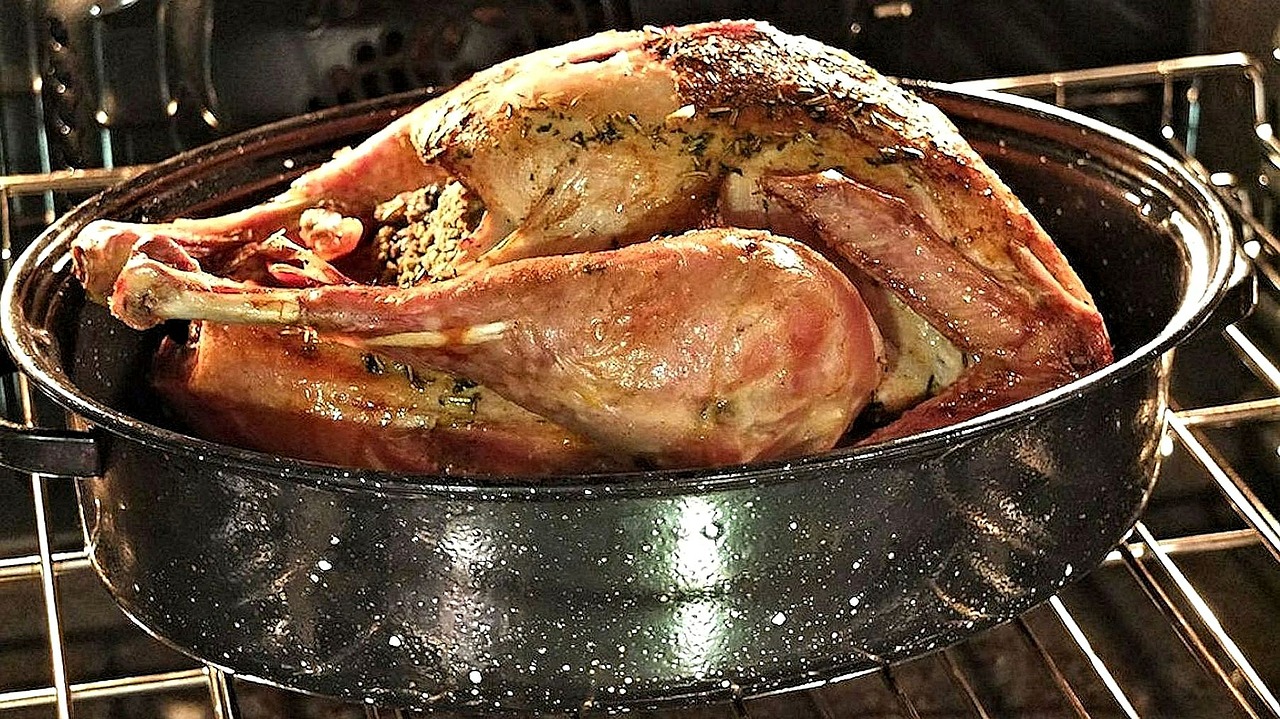
You can save a great deal of money when raising turkeys for profit by processing them at the right time. Some farmers will try to grow their turkeys out to considerable weights because they are under the impression people will only purchase turkeys which are 20+ pounds.
However, this will take more time and money because of the feed. Not to mention, trying to wrangle a 20-pound turkey to process is going to make for a difficult time.
Therefore, raise your turkeys for approximately five to six months (depending upon breed) and harvest when they’re around 10-14 pounds.
If you have customers who want larger birds, convince them it will make the turkey more affordable and easier to manage in the kitchen at this size. Let them know they could buy two birds for the same or lesser price and still end up with the same weight of turkey meat.
It will help you save money, lessen your investment of time, and still be able to offer an affordable price for locally raised turkeys while still making a profit.
Customers, Laws, and Legalities
This is the last but most crucial part of raising turkeys for profit. You must make sure you have a customer base.
You won’t be able to beat the prices of store-bought turkey. Commercial growers have different methods for raising turkeys meant to produce birds quickly, with less expense, a lower price for the customer, and to make the producer more money.
However, some people don’t agree with the methods used. They want to know their meat had a good life, it was handled as humanely as possible, it was fed as healthy a diet as possible, and some like to select their bird before it is processed.
When creating your price, add up all your expenses, your time invested, and a slight mark-up to make your money back and a little extra. It’s a good idea to check competitors’ prices to make sure you aren’t too high, or no one will buy from you.
Also, check your local laws for selling meat. Some states require you to pass an inspection and be registered with your county before you can sell meat at the local Farmer’s Market or even as a personal business run out of your home.
You should also check into liability issues and know how to protect yourself from any legal action if you end up with an unhappy customer.
Raising turkeys for profit is no small feat. It requires ingenuity, hard work, and some marketing skills to make it all come together.
But if you can produce a quality bird and people can taste the difference between your hard work and the meat purchased from a local chain market, they’ll come back every year.
We wish you all the best in raising turkeys for profit and hope this could become a potential income booster for your homestead.


